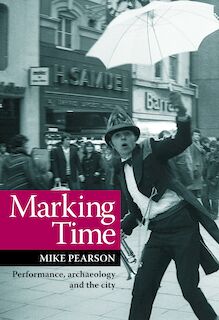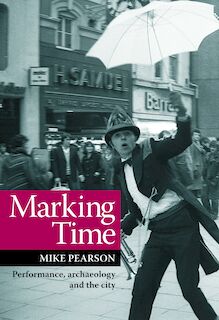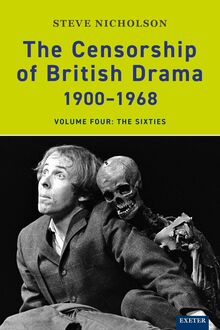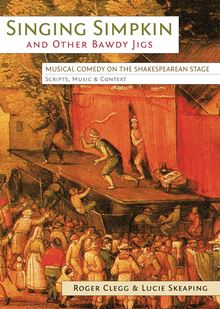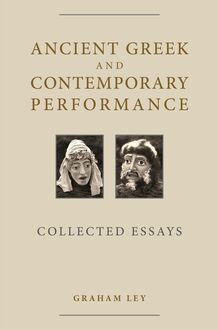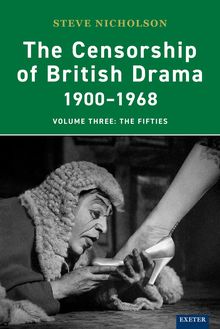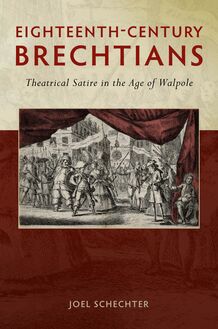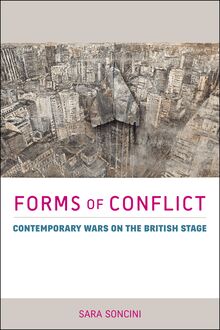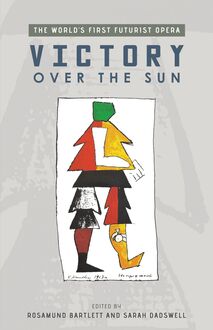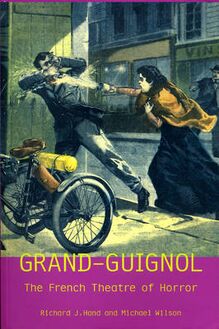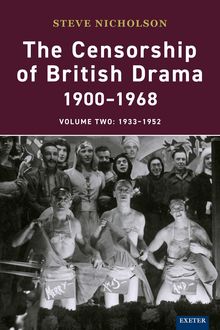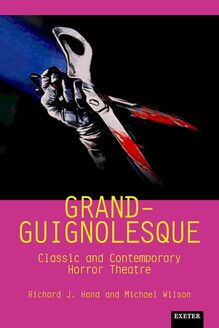London’s Grand Guignol and the Theatre of Horror , livre ebook
202
pages
English
Ebooks
2019
Vous pourrez modifier la taille du texte de cet ouvrage
Obtenez un accès à la bibliothèque pour le consulter en ligne En savoir plus
Découvre YouScribe en t'inscrivant gratuitement
Découvre YouScribe en t'inscrivant gratuitement
202
pages
English
Ebooks
2019
Vous pourrez modifier la taille du texte de cet ouvrage
Obtenez un accès à la bibliothèque pour le consulter en ligne En savoir plus
Publié par
Date de parution
17 juillet 2019
Nombre de lectures
3
EAN13
9781905816361
Langue
English
Poids de l'ouvrage
2 Mo
A companion to UEP’s Grand-Guignol: The French Theatre of Horror (now in its third reprint). A genre that has left more of a mark on British and American culture than we may imagine” (Gothic Studies).
London’s Grand Guignol was established in the early 1920s at the Little Theatre in the West End. It was a high-profile venture that enjoyed popular success as much as critical controversy. On its side were some of the finest actors on the English stage, in the shape of Sybil Thorndike and Lewis Casson, and a team of extremely able writers, including Noël Coward.
London's Grand Guignol and the Theatre of Horror considers the importance and influence of the English Grand Guignol within its social, cultural and historical contexts. It also presents a selection of ten remakarble English-language Grand Guignol plays, some of which were banned by the Lord Chamberlain, the censor of the day, and have never been published or publicly performed. Among the plays in the book is a previously unpublished work by Noël Coward, The Better Half, first performed at the Little Theatre in 1922.
The reviewer in the journal Gothic Studies wrote, of the authors’ previous book: “having recently taught a module on Grand Guignol with third year drama students, it is also worth noting that this book captured their imaginations in a way that few other set texts seem to manage.”
SECTION 1
Chapter 1: A History of London’s Grand Guignol
Chapter 2: London’s Grand Guignol and Issues of Genre and Writing
Chapter 3: London’s Grand Guignol: Performers and Performing
Chapter 4: London’s Grand Guignol: Censorship and Reception
Chapter 5: London’s Grand Guignol and the Reviewers
Chapter 6: The Aftermath and Legacy of London’s Grand Guignol
SECTION 2
Ten Plays of London’s Grand Guignol
Eight O’Clock by Reginald Berkeley
A Man in Mary’s Room by Gladys Unger
Private Room Number 6 by André de Lorde
The Person Unknownby H. F. Maltby
Latitude 15°Southby Victor MacClure
The Old Women by Christopher Holland
The Nutcracker Suite by Eliot Crawshay-Williams
The Sisters’ Tragedy by Richard Hughes
The Better Half by Noël Coward
I Want To Go Home by H. F. Maltby
APPENDICES
Appendix 1 London’s Grand Guignol, 1920-22Appendix 2 The Complete Repertoire of London’s Grand Guignol, 1920-22
Appendix 3 Extract from Oh, Hell!!! A ‘Revuette’ by Reginald Arkell and Russell Thorndike
Bibliography
Publié par
Date de parution
17 juillet 2019
Nombre de lectures
3
EAN13
9781905816361
Langue
English
Poids de l'ouvrage
2 Mo
London’s Grand Guignol and the Theatre of Horror
A companion to Grand-Guignol—The French Theatre of Horror
“When José Levy staged the world première of The Old Women by the ‘Prince of Terror’ André de Lorde in 1921 as part of the fourth series of Grand Guignol at the Little Theatre, he commissioned Aubrey Hammond to create a publicity poster in a Beardsley style. So harrowing was Hammond’s poster that it was banned by London Underground. Hammond also produced a publicity postcard for the theatre, a cartoon drawing of a horrified audience, literally running screaming from the auditorium. As with the original Théâtre du Grand-Guignol in Paris, stories circulated of audience members fainting or being physically sick before the on-stage horrors they witnessed. London’s Grand Guignol was a sensation and audiences ventured there at their own risk to share in the thrills and chills on offer.”
from the first chapter of London’s Grand Guignol and the Theatre of Horror
Richard J. Hand and Michael Wilson are Professors of Drama, both at the Cardiff School of Creative and Cultural Industries at the University of Glamorgan. Together they have delivered workshops on Grand Guignol, and presented Grand Guignol performances at universities, international conferences and at the Edinburgh Fringe Festival.
Also by Richard J. Hand and Michael Wilson: Grand-Guignol—The French Theatre of Horror (University of Exeter Press, 2002)
Exeter Performance Studies
Series editors: Peter Thomson, Professor of Drama at the University of Exeter; Graham Ley, Professor of Drama and Theory at the University of Exeter; Steve Nicholson, Reader in Twentieth-Century Drama at the University of Sheffield.
From Mimesis to Interculturalism: Readings of Theatrical Theory Before and After ‘Modernism’
Graham Ley (1999)
British Theatre and the Red Peril: The Portrayal of Communism 1917–1945
Steve Nicholson (1999)
On Actors and Acting
Peter Thomson (2000)
Grand-Guignol: The French Theatre of Horror
Richard J. Hand and Michael Wilson (2002)
The Censorship of British Drama 1900–1968: Volume One 1900–1932
Steve Nicholson (2003)
The Censorship of British Drama 1900–1968: Volume Two 1933–1952
Steve Nicholson (2005)
Freedom’s Pioneer: John McGrath’s Work in Theatre, Film and Television
edited by David Bradby and Susanna Capon (2005)
John McGrath: Plays for England
selected and introduced by Nadine Holdsworth (2005)
Theatre Workshop: Joan Littlewood and the Making of Modern British Theatre
Robert Leach (2006)
Making Theatre in Northern Ireland: Through and Beyond the Troubles
Tom Maguire (2006)
“In Comes I”: Performance, Memory and Landscape
Mike Pearson (2006)
First published in 2007 by University of Exeter Press Reed Hall, Streatham Drive Exeter EX4 4QR UK www.exeterpress.co.uk
© 2007 Section One and all editorial material, Richard J. Hand and Michael Wilson; the plays, as indicated in the prefaces to the play texts
The right of Richard J. Hand and Michael Wilson to be identified as authors of this work has been asserted by them in accordance with the Copyright, Designs and Patents Acts 1988.
British Library Cataloguing in Publication Data A catalogue record for this book is available from the British Library.
Paperback ISBN 978 0 85989 792 1 Hardback ISBN 978 0 85989 789 1 ePub ISBN 978 1 90581 6361 PDF ISBN 9780 85989 927 7
Typeset in Sabon, 10 on 12 by Carnegie Book Production, Lancaster
To Shara, Danya and Jimahl (RJH)
To Phillip, Gemma and Hannah (MW)
Frontispiece : Aubrey Hammond: London’s Grand Guignol, 1921
1
Contents
List of illustrations
Acknowledgements
SECTION 1
1 A History of London’s Grand Guignol
2 Issues of Genre and Writing
3 Performers and Performing
4 Censorship and Reception
5 London’s Grand Guignol and the Reviewers
6 Aftermath and Legacy
SECTION 2: Ten Plays of London’s Grand Guignol
Eight O’Clock
by Reginald Berkeley
A Man in Mary’s Room
by Gladys Unger
Private Room Number 6
by André de Lorde and Pierre Chaine
The Person Unknown
by H.F.Maltby
Latitude 15° South
by Victor MacClure
The Old Women
by Christopher Holland
The Nutcracker Suite
by Eliot Crawshay-Williams
The Sisters’ Tragedy
by Richard Hughes
The Better Half
by Noël Coward
I Want To Go Home
by H.F.Maltby
APPENDICES
1 London’s Grand Guignol, 1920–1922
2 The Complete Repertoire of London’s Grand Guignol, 1920–1922
3 Extract from Oh, Hell!!! A ‘Revuette’ by Reginald Arkell and Russell Thorndike
Bibliography
Index
Illustrations
Cover illustration Postcard Image of London’s Grand Guignol audience by Aubrey Hammond
Frontispiece Aubrey Hammond: London’s Grand Guignol, 1921
1 José G.Levy
2 Seven Blind Men , 1921 (note the heavy make-up used on Lewis Casson (third from right))
3 Sybil Thorndike, Russell Thorndike and Lewis Casson in Oh, Hell!!! , 1920
4 Victor Hicks cartoon in The Stage (11 August 1921)
5 Jean de Bosschère’s ‘Impression’ in the Sketch (2 November 1921)
6 Lewis Casson and Russell Thorndike in Latitude 15° South , 1921
7 Lea (Sybil Thorndike) and Gregorff (George Bealby) in Private Room Number 6 , 1920
8 Aubrey Hammond: Poster for London’s Grand Guignol, 1920
9 Louise (Sybil Thorndike) in The Old Women , 1921
La Borgnesse (Russell Thorndike) and Louise (Sybil Thorndike) in The Old Women , 1921
10 The ‘Eye Gouging’ Scene in The Old Women , 1921: Russell Thorndike and Athene Seyler look down upon Barbara Gott and, with bandaged eyes, Sybil Thorndike
11 George Bealby, Sybil Thorndike and Lewis Casson in The Hand of Death , 1920
12 Programme cover featuring the logo of London’s Grand Guignol by Aubrey Hammond, 1921
13 Stockwell Hawkins, Ralph Neale, Russell Thorndike and Lewis Casson in Eight O’Clock , 1920
14 Aubrey Hammond: Poster for Private Room Number 6 , 1920
15 Daisy (Sybil Thorndike) in The Person Unknown , 1921
16 Aubrey Hammond: Poster for The Old Women , 1921
17 Rosalie (Sybil Thorndike) and Max (Ian Fleming) in The Nutcracker Suite , 1922
18 Lowrie (Elizabeth Arkell) and Owen (Brember Wills) in The Sisters’ Tragedy , 1922
Acknowledgements
The authors would like to express their gratitude to the following individuals and organisations who have offered support of one sort or another during the preparation of this book:
The British Academy and the Society for Theatre Research for their generous financial support.
University of Exeter Press: Simon Baker and all the team; Peter Thomson, Graham Ley and Steve Nicholson for painstakingly reviewing early drafts of the manuscript.
University of Glamorgan: Colleagues in the Department of Drama and Music for their interest in and support of this continuing project; students from the Division of Drama who have persisted in asking searching questions and helped bring some of this research work to life in the drama studio.
Libraries: Staff at the British Library (St. Pancras and Colindale) and the National Library of Wales for their help in tracking down our obscure requests.
Plays: Alan Brodie Representation and the Noël Coward Estate for permission to reprint The Better Half ; Samuel French Ltd for permission to reprint The Nutcracker Suite ; David Higham Associates for permission to reprint The Sisters’ Tragedy .
San Francisco: Russell Blackwood and Thrillpeddlers; Brad Rosenstein and the San Francisco Performing Arts Library and Museum, all for hospitality and unfailingly good-humoured conversations.
Mick Eaton for his enthusiasm and generosity especially in relation to Fred Paul’s Grand Guignol films.
And, of course, to both our families for their unconditional love and support.
SECTION 1
1
A History of London’s Grand Guignol
When José Levy staged the world première of The Old Women by the ‘Prince of Terror’ André de Lorde in 1921 as part of the fourth series of Grand Guignol 1 plays at the Little Theatre, he commissioned Aubrey Hammond to create a publicity poster in a Beardsley style, much as he had done for all of Levy’s Grand Guignol seasons. So harrowing was Hammond’s poster that it was banned by London Underground.
Hammond had also produced a publicity postcard for the theatre, a cartoon drawing of a horrified audience, literally running screaming from the auditorium. As with the original Théâtre du Grand Guignol in the rue Chaptal in Paris, the theatre that Levy was attempting to replicate in London, stories circulated of audience members fainting or being physically sick before the on-stage horrors they witnessed. London’s Grand Guignol was a sensation and audiences ventured there at their own risk to share in the thrills and chills on offer.
And yet also, as with the Parisian Grand Guignol, many of those stories were exaggerated for their own ends, to create the myth of a theatre heavily charged with eroticism and where the blood flowed freely. In reality, London’s Grand Guignol was a much more genteel, indeed British affair, checked on the one hand by the Lord Chamberlain, the public censor, and on the other hand by the tastes of the London theatre-going public. Sex was suggested, rather than explicit, and where disembowellings and throat-slittings were nightly events on the stage of the Parisian Grand Guignol, at the Little Theatre a poisoning or a strangulation was generally preferable.
Levy’s project was a genuine success and, as tame as some of the plays may seem today, they were disturbing enough to their audience to scandalize certain sections of the press and to severely test the limits and the patience of the Lord Chamberlain. What Levy had on his side were some of the finest actors on the English stage at the time, in the shape of Sybil Thorndike and Lewis Casson, and a team of extremely able writers, such as Eliot Crawshay-Williams, Sewell Collins, H.F.Maltby and Noël Coward. In addition he had the Zeitgeist on his side, a post-war public that was eager for thrills and excitement – the artificial, high theatricality of on-sta
